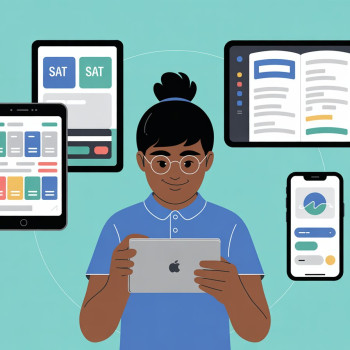Introduction: Why Family Rhythm Matters for SAT Prep
When your teen opens their laptop to practice the Digital SAT, it’s not just them versus a screen — it’s a whole-family moment. The transition to the digital format changed test timing, delivery, and the day-of experience, but the underlying truth remains: preparation is easier and far more effective when families build a supportive, organized routine around it.
This article is for parents who want practical, realistic, and emotionally intelligent ways to adjust family schedules so SAT prep fits into life — rather than life bending under the weight of test prep. Expect clear strategies, sample schedules, a comparison table to help you choose what fits, and a few honest tactics to keep your student motivated without turning dinner into a study hall. We’ll also mention how services like Sparkl’s personalized tutoring can be woven into your plan when one-on-one, tailored support is helpful.

Start with Why: Align Family Goals and the Test Timeline
Before shifting clocks or cutting activities, have a family conversation. Understanding the “why” keeps everyone motivated and prevents SAT prep from becoming a secret burden on your teen.
Questions to guide the family conversation
- Why is this SAT sitting on your teen’s plan? (College applications, scholarship targets, confidence building?)
- When is the test date or school-administered SAT School Day? Are there backup dates? (Mark those on a shared calendar.)
- What are the non-negotiables — school hours, sports practices, family duties?
- What level of support does your teen want — daily check-ins, quiet time, or an occasional coach?
When parents and students agree on goals and boundaries, schedule adjustments feel purposeful rather than punitive.
Design a Realistic Weekly SAT Prep Rhythm
A weekly rhythm creates momentum. It doesn’t have to be rigid — flexibility matters because fatigue, busy weeks, and life events will happen. Use a rhythm that balances focused study, regular breaks, and consistent sleep.
Core principles when building a weekly plan
- Quality over quantity: 30–60 focused minutes of deliberate practice beats two hours of distracted review.
- Consistency beats cramming: shorter, daily practice embeds skills better than one long weekend session.
- Building habit anchors: attach study to an existing routine — after dinner, right after school, or morning review with breakfast.
- Rest is part of prep: schedule full rest days and consistent sleep times.
Sample weekly schedules (choose what fits)
| Family Type | Weekly SAT Time | Key Features |
|---|---|---|
| Busy-But-Steady | 5–6 sessions × 30 min | Short daily micro-sessions, morning vocabulary, two weekend practice sets |
| Activity-Heavy | 4 sessions × 45–60 min | After-practice wind-down study, weekly full-length practice on a quiet weekend morning |
| Test-Focused | 5–7 sessions × 60–90 min + 1 full practice test | More targeted problem sets, frequent review cycles, optional tutoring sessions |
These templates are starting points. If your student has access to personalized tutoring — for example, Sparkl’s 1-on-1 guidance and AI-driven insights — slot those sessions into the weeks with heavy review and assessment so lessons feed directly into daily practice.
Daily Logistics: Small Adjustments with Big Payoff
Shifting routines doesn’t require upheaval. Tiny structural changes align the household to support focused studying without resentment.
Practical daily tweaks
- Quiet Hour: Establish one consistent quiet hour each evening where screens are limited and your student uses the time for practice or review.
- Shared Calendar: Use a visible calendar (digital or on the fridge) with practice sessions, test dates, and tutoring appointments highlighted so everyone knows what to expect.
- Homework-Study Block: If schoolwork is heavy, place a short SAT practice block before larger assignments — cognitive freshness helps.
- Sleep Priority: Aim for regular bedtimes. Even a 30-minute sleep shift can change concentration the next day.
- Meal Prep: Plan simple, brain-friendly dinners on practice nights (lean protein, whole grains, veggies) to reduce evening decision fatigue.

Balancing Extracurriculars Without Sacrificing Growth
Extracurriculars build a powerful college profile, so parents often worry they’ll have to be cut. The goal is balance — not elimination.
How to decide which activities to scale back
- Assess impact: Keep activities that provide growth, leadership, or joy. Temporarily reduce administrative or low-impact commitments.
- Seasonal swaps: Reduce extracurricular hours in the 6–8 weeks before a target test date; pick them back up afterward.
- Communicate with coaches and club leaders: Explain prep priorities and seek flexible practice times.
- Micro-practices: Allow short SAT sessions on travel days or between activities — 20 focused minutes can be surprisingly effective.
Remember, colleges value depth, consistency, and impact. A well-timed pause in some activities for the sake of better SAT performance and mental health is reasonable and strategic.
Weekend Strategy: Make Weekends Count Without Burning Out
Weekends should include deliberate practice and also restorative time. Structure matters: alternate between practice intensity and restoration.
Weekend blueprint
- Saturday morning: one full or half-length practice section (timed) followed by a review session.
- Saturday afternoon: active recovery — family time, light hobby, or outdoor activity.
- Sunday: shorter review, targeted drills (grammar rules, math formulas), and planning the week ahead.
- Pre-test weekend: keep it light — a familiar practice test, sleep hygiene, and a calm family dinner.
Use weekends to simulate test-day conditions occasionally. Practice in the same time-of-day slot as the actual SAT to build circadian familiarity.
When to Add Outside Help: Tutoring, Practice Tests, and Reviews
Many families wonder when to bring in a tutor. If your teen is consistently plateauing, losing confidence, or juggling an intense schedule, personalized tutoring can be the accelerant that focuses their progress.
Signs a tutor might help
- Performance plateau across multiple practice tests.
- Inconsistent study habits that a coach can structure.
- Specific gaps — e.g., data analysis in math or evidence-based reading techniques.
- A need for accountability and tailored strategies rather than generic practice.
When you do hire help, schedule sessions to complement — not replace — daily practice. Services like Sparkl’s personalized tutoring offer 1-on-1 guidance, tailored study plans, and AI-driven insights that can be slotted into weekly rhythms. These sessions can serve as both instruction and accountability checkpoints.
Test-Week Plan: Calm, Confidence, and Logistics
In the week leading up to test day, shift focus from content accumulation to maintenance, strategy, and logistics. The goal is to arrive sharp, rested, and confident.
Seven-day checklist
- Reduce study intensity — focus on light review, formulas, and test strategies.
- Confirm test day logistics: time, app requirements (Bluebook), ID, and transportation.
- Practice with the exact setup: laptop, allowed tools, and headphones if used.
- Practice sleep: keep bed and wake times consistent.
- Pack the night before: water bottle, snacks (if allowed), and a backup charger for devices.
- Plan a calm, celebratory family activity after the test — something to look forward to.
Emotional Support: Keep Motivation Positive and Sustainable
Test prep is as much emotional work as intellectual work. Parents are part coach, part buffer, and part cheerleader.
Communication strategies that help
- Ask, don’t tell: “What would help you study today?” invites collaboration.
- Recognize effort publicly: celebrate milestones like completed practice tests or improved timed scores.
- Normalize setbacks: grade-greedy reactions can drain motivation; model problem-solving instead.
- Use rewards wisely: opt for intrinsic reinforcement (confidence, mastery) supplemented by small, tangible rewards.
When stress spikes, step back and consider temporary adjustments — fewer practice minutes with higher-quality focus can preserve momentum without breakdown.
Technology and Tools: Make the Digital Format Work for You
The Digital SAT’s platform affects logistics and preparation. Familiarity with the testing app and digital practice builds confidence and avoids test-day surprises.
Household tech checklist
- Practice on the Bluebook app or official practice tests in the same environment your teen will test in if possible.
- Ensure reliable internet during prep sessions and have an offline plan for practice runs.
- Set up a quiet, well-lit study space with a good chair and minimal interruptions.
- Teach basic troubleshooting: what to do if an app freezes or the internet drops.
Parents who understand the testing environment can reduce anxiety by role-playing test-day technical steps in advance.
Sample Family Schedule (6-Week Focused Prep)
| Day | Morning | Afternoon | Evening |
|---|---|---|---|
| Monday | Light review (20 min) | School | Timed practice (40 min) |
| Tuesday | Vocabulary/practice questions (20 min) | School + activity | Targeted math drills (45 min) |
| Wednesday | Morning review (20 min) | School | Family dinner + short review (30 min) |
| Thursday | Passage reading (20 min) | School | Tutor session / Sparkl check-in (1 hour every other week) |
| Friday | Restorative morning | School | Light review + relax |
| Saturday | Full practice set (timed) | Review mistakes with parent or tutor | Family downtime |
| Sunday | Target drills (30 min) | Plan week + errands | Early bedtime |
Cost, Time, and Tradeoffs: An Honest Conversation
Adjusting schedules has tradeoffs. Maybe your teen declines a club leadership role this season or reduces weekend shift hours. Weigh the short-term tradeoff against the long-term payoff: better test performance can open scholarship opportunities and college choices.
Budget wise, tutoring and test prep vary widely. Prioritize targeted support — a few high-quality tutoring sessions focusing on weaknesses can be more efficient than long, unstructured study.
Final Thoughts: Partnership Over Pressure
Parents often ask: “How involved should I be?” The answer is: engaged, but not controlling. Your role is to create the conditions — consistent schedules, nourishing routines, logistical support, and emotional steadiness — that allow your teen to build confidence and skills. Offer structure, celebrate progress, and seek help (like personalized tutors from Sparkl or other trusted educators) when the path gets rocky.
Preparing for the Digital SAT is a family project in the best sense: when parents and students collaborate with clear goals and a flexible, humane schedule, the work becomes manageable and even meaningful. Remember — this test is a milestone, not the finish line. Thoughtful planning now preserves your teen’s wellbeing and opens doors later.
Quick Checklist for Parents (Keep This Handy)
- Have a family goal-setting conversation and mark test dates on a shared calendar.
- Create a weekly rhythm: short daily practice + one focused weekend session.
- Prioritize sleep and nutrition during heavy prep windows.
- Limit low-value activities temporarily; protect high-impact extracurriculars.
- Consider targeted 1-on-1 tutoring when progress stalls — integrate sessions into your schedule.
- Run a tech rehearsal of the testing app and troubleshoot devices ahead of time.
- Keep emotional check-ins regular and celebrate small wins.
A Final Note of Encouragement
Adjusting a family schedule for SAT prep is less about squeezing in more hours and more about creating a predictable, supportive atmosphere where focused practice thrives. With clear communication, small structural tweaks, and targeted support, families can help students approach the Digital SAT calm, capable, and confident.
And if your teen could benefit from a tailored plan or occasional expert guidance, exploring personalized tutoring options — including 1-on-1 coaching, customized study plans, and AI-informed insights — can be a smart addition to the family strategy. When everyone pitches in thoughtfully, the test becomes one step on a shared journey toward college and beyond.















No Comments
Leave a comment Cancel